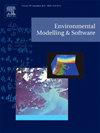An open framework for analysing future flood risk in urban areas
IF 4.8
2区 环境科学与生态学
Q1 COMPUTER SCIENCE, INTERDISCIPLINARY APPLICATIONS
引用次数: 0
Abstract
A combination of climate change and urban development are increasing flood risk in cities worldwide, however analysing both drivers of risk is especially complex as new buildings alter surface water flows changing flood events. This paper provides an overview of the approaches, algorithms, design, and capabilities of the OpenCLIM urban flooding workflow which attempts to address this, coupling building-scale models of urban development with high-resolution simulations of urban flooding. The workflow retrieves and processes national-scale datasets, automatically configuring data and models, thereby significantly reducing user effort in commissioning simulations of risk analysis. A demonstration for Newcastle-upon-Tyne (UK) reveals hotspots of changes in risk and exposure are altered by both urban development and changes in rainfall, with climate change the most significant driver. The workflow is made accessible and transparent via DAFNI (www.dafni.ac.uk), a national computing facility, providing a vital tool for routine and repeatable urban flood risk analysis.

分析市区未来洪水风险的开放架构
气候变化和城市发展的结合正在增加世界各地城市的洪水风险,然而,分析这两个风险驱动因素尤其复杂,因为新建筑改变了地表水的流动,从而改变了洪水事件。本文概述了OpenCLIM城市洪水工作流的方法、算法、设计和功能,该工作流试图解决这一问题,将城市发展的建筑尺度模型与城市洪水的高分辨率模拟相结合。该工作流检索和处理全国范围的数据集,自动配置数据和模型,从而大大减少了用户在调试风险分析模拟时的工作量。泰恩河畔纽卡斯尔(英国)的一项示范显示,城市发展和降雨变化改变了风险和暴露变化的热点,其中气候变化是最重要的驱动因素。工作流程可通过DAFNI (www.dafni.ac.uk)透明访问,DAFNI是一个国家计算设施,为常规和可重复的城市洪水风险分析提供了重要工具。
本文章由计算机程序翻译,如有差异,请以英文原文为准。
求助全文
约1分钟内获得全文
求助全文
来源期刊

Environmental Modelling & Software
工程技术-工程:环境
CiteScore
9.30
自引率
8.20%
发文量
241
审稿时长
60 days
期刊介绍:
Environmental Modelling & Software publishes contributions, in the form of research articles, reviews and short communications, on recent advances in environmental modelling and/or software. The aim is to improve our capacity to represent, understand, predict or manage the behaviour of environmental systems at all practical scales, and to communicate those improvements to a wide scientific and professional audience.
 求助内容:
求助内容: 应助结果提醒方式:
应助结果提醒方式:


